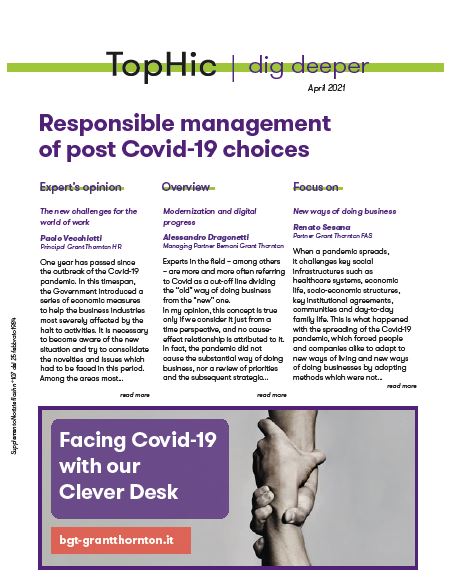-
Transactional advisory services
Find out more about the transactional advisory services of Grant Thornton Financial Advisory Services
-
Valuations
Find out more about the valuations services of Grant Thornton Financial Advisory Services
-
Mergers and acquisitions
Find out more about the merger and acquisition services of Grant Thornton Financial Advisory Services
-
Forensic and investigation services
Find out more about the forensic and investigation services of Grant Thornton Financial Advisory Services
-
Recovery & reorganisation
Find out more about the Recovery & reorganisation services of Grant Thornton Financial Advisory Services
-
Business risk services
Find out more about the business risk services of Grant Thornton Financial Advisory Services
-
Business consulting
Find out more about the business consulting services of Grant Thornton Financial Advisory Services
-
Capital market
Capital market
-
Corporate and business tax
Find out more about our corporate and business tax services.
-
Direct international tax
Find out more about our direct international tax services.
-
Global mobility services
Find out more about our global mobility services.
-
Indirect international tax
Find out more about our indirect international tax services.
-
Transfer pricing
Find out more about our transfer pricing services.
-
Litigation
Our lawyers and accountants can manage all defense measures provided not only by the Italian law, but also by EU regulations and conventions
-
Family business
Find out more about our Family business services.
-
Legal
The client can be assisted in every need and with the same care both on important operations or disputes and on simple matters

-
Back office outsourcing
Find out more about our Back office outsourcing services
-
Business process outsourcing
Find out more about our business process outsourcing services.
-
Compilation of financial statements
Find out more about our compilation of financial statements services.
-
Tax compliance
Find out more about our tax compliance services.
-
Electronic invoicing
Find out more about our electronic invoicing services
-
Electronic storage
Electronic storage is an archiving procedure that guarantees the legal validity of a digitally stored electronic document
-
Revaluation of corporate assets
Find out your civil and fiscal revaluation of tangible, intangible and financial assets
-
Human resources consulting
Find out more about our human resources consulting services.
-
Payroll
Find out more about our payroll services.
-
HR News
HR News the monthly information newsletter by Grant Thornton HR
-
Cybersecurity
GT Digital helps clients structure information security management internal functions, also through partially or totally outsourced functions
-
Agile and Programme Management
GT Digital provides support in the adoption and implementation of different portfolio management
-
Robotic Process Automation
Our “BOT Farm” can rely on digital workers able to help clients in routine activities, allowing employees to deal with more added-value activities
-
Data strategy and management
GT Digital can support clients in seizing the opportunities offered by Big Data, from the definition of strategies to the implementation of systems
-
Enterprise Resource Planning
We support clients in selecting the most appropriate ERP System according to their specific needs, helping them also understand licensing models
-
IT strategy
GT Digital supports clients in making strategic choices, identifying innovation opportunities, comparing themselves with competitors
-
IT service management
We can support with software selection and with the implementation of dedicated tools for the management of ICT processes
-
DORA and NIS 2
The entry into force of the DORA Regulation and NIS2 represents a major step towards the creation of a harmonised regulatory framework
Experts in the field – among others – are more and more often referring to Covid as a cut-off line dividing the “old” way of doing business from the “new” one.
In my opinion, this concept is true only if we consider it just from a time perspective, and no cause-effect relationship is attributed to it.
In fact, the pandemic did not cause the substantial way of doing business, nor a review of priorities and the subsequent strategic and planning decisions. Covid-19 has only speeded up a process that – though the related slow-downs and resistance - had been ongoing for a long time (even if with a different pace at a global level).
Most industrialized countries in the world, in fact, started moving towards the fourth industrial revolution a long time ago, according to common directives and, since 2013 to date, Industry 4.0 has been included in the agenda of all main governments, with the aim of making economy increasingly more agile and efficient, thanks to digital, automated and interconnected processes. Therefore, the modernization and, particularly, the digital progress, determined – and will determine – significant changes, not only in trends and needs of businesses, but also in the strategies of the main stakeholders.
Limiting the scope of the analysis to Italy, we can see that, already at the end of 2019, according to the first permanent census of enterprises carried out by ISTAT (National statistics institution), approximately ¾ of companies having more than ten employees were involved in digital investment. Only 3.8% of them, however, were already in their digital maturity phase, while most of them were still “testing” new technological and organizational solutions. Other countries in Europe, America, and Asia were considerably ahead of Italy.
The considerations following the abovementioned analysis are quite simple: since March 2020, the global economy has been disruptively changing its logics and, therefore, its operators, both buyers (B2B and B2C) and sellers, were inevitably involved.
This has implied a substantial change in many aspects, such as the economic and financial, as well as lifestyle-related needs, the way these needs are met (which is increasingly more dematerialized), the importance of the time factor (both for the delivery and for the utilization of goods or services), the relevance of the risk factor (not only the risk related to the counterparty but also that being implicit in the organization).
Starting from this fundamental consideration, companies and advisors are called to identify and deal with the main innovations they will be concerned by, considered that the longed-for end of the pandemic will imply the end of the effects of the provisions that have mitigated the impact related to disruption.
The end of the pandemic, in fact, will not imply a return to the status quo, but rather the continuation of the trend towards change, without any (regulatory and statutory) facilitating element.
Therefore, according to this vision, some aspects such as remote working, the cyber phenomenon, the review of organizational processes, the adjustment of compliance due to the changes in the management of commercial relationships, the review of intercompany agreements within cross-country transactions, etc., will need to be preventively analysed in order to plan the proper actions to take.
Some questions will also need to be answered:
- How will remote working – once it is fully operational – impact in organizational, regulatory, and financial terms?
- What processes will have to be implemented and/or changed in the light of a more massive use of digitalization?
- How will commercial relationships (even intercompany ones) change in accordance to modern business models oriented to the disintermediation and dematerialization of transactions?
- What are the risks, which companies should prevent and, most of all, how can they do it?
- How could companies leverage the motivation of the most important factor of production, i.e. human resources?
Such questions, as other ones, require a preventive analysis, since their resolution will impact on medium- and long-term strategies, on cash flows, on already assumed commitments, and on traditional evaluation parameters used so far.
Those who will be able to adopt this approach will take a certain, durable, and sustainable advantage, while those who will not operate according to this approach (maybe remaining in their comfort zone) will risk to suffer significant consequences that will impact the sustainability of their business in the medium-long term.


